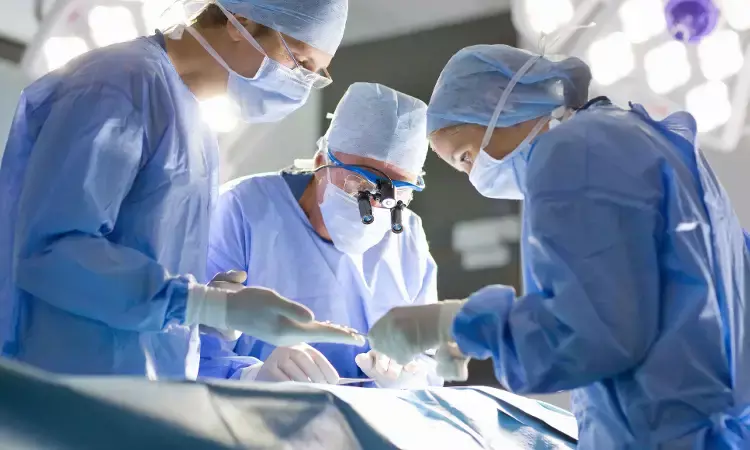- Home
- Medical news & Guidelines
- Anesthesiology
- Cardiology and CTVS
- Critical Care
- Dentistry
- Dermatology
- Diabetes and Endocrinology
- ENT
- Gastroenterology
- Medicine
- Nephrology
- Neurology
- Obstretics-Gynaecology
- Oncology
- Ophthalmology
- Orthopaedics
- Pediatrics-Neonatology
- Psychiatry
- Pulmonology
- Radiology
- Surgery
- Urology
- Laboratory Medicine
- Diet
- Nursing
- Paramedical
- Physiotherapy
- Health news
- Fact Check
- Bone Health Fact Check
- Brain Health Fact Check
- Cancer Related Fact Check
- Child Care Fact Check
- Dental and oral health fact check
- Diabetes and metabolic health fact check
- Diet and Nutrition Fact Check
- Eye and ENT Care Fact Check
- Fitness fact check
- Gut health fact check
- Heart health fact check
- Kidney health fact check
- Medical education fact check
- Men's health fact check
- Respiratory fact check
- Skin and hair care fact check
- Vaccine and Immunization fact check
- Women's health fact check
- AYUSH
- State News
- Andaman and Nicobar Islands
- Andhra Pradesh
- Arunachal Pradesh
- Assam
- Bihar
- Chandigarh
- Chattisgarh
- Dadra and Nagar Haveli
- Daman and Diu
- Delhi
- Goa
- Gujarat
- Haryana
- Himachal Pradesh
- Jammu & Kashmir
- Jharkhand
- Karnataka
- Kerala
- Ladakh
- Lakshadweep
- Madhya Pradesh
- Maharashtra
- Manipur
- Meghalaya
- Mizoram
- Nagaland
- Odisha
- Puducherry
- Punjab
- Rajasthan
- Sikkim
- Tamil Nadu
- Telangana
- Tripura
- Uttar Pradesh
- Uttrakhand
- West Bengal
- Medical Education
- Industry
Photoselective sharp enucleation helps in effective treatment of BPH: BMC

In case of benign prostatic hyperplasia (BPH), photoselective sharp enucleation of the prostate (PSEP) removes more tissue than photoselective vaporization of the prostate (PVP) and is effective and safe for treatment. This study was published in the BMC Urology.
This study by Zhengchao Liu and peers included a total of 154 patients from June 2018 to April 2019 who were diagnosed with bladder outlet obstruction additional to BPH were divided randomly into PSEP and the PVP group. Preoperatively all the patients were assessed and postoperatively followed up at 1, 6, and 12 months. Between the treatment options international prostate symptom score, quality-of-life score, postvoid residual urine volume, maximum urine flow rate, prostate volume, prostate-specific antigen, and adverse events were compared .
The findings of this study were:
- Postoperatively, lower urinary tract symptoms in both groups were significantly improved compared with the baseline at 1, 6, and 12 months.
- At each follow up, both the groups had an equivalent International Prostate Symptom Score, quality-of-life score, postvoid residual urine volume, maximum urine flow rate and prostate-specific antigen.
- The median operative time in the PSEP group was significantly shorter than that in the PVP group (35 min vs. 47 min, P < 0.001).
- The median Prostate Volume in the PSEP group was comparatively smaller than the PVP group at 6 months and 12 months following surgery.
The authors suggest that PSEP can remove more tissue compared to PVP and it eliminates the lack of tissue samples problem, this can highly reduce the risk of missed prostate cancer diagnosis.
Reference:
Liu, Z., Chen, Z., Yan, D., Jiang, T., Fu, J., Zheng, J., Zhou, Y., Zhou, Z., & Shen, W. (2022). Photoselective sharp enucleation of the prostate with a front-firing 532-nm laser versus photoselective vaporization of the prostate in the treatment of benign prostatic hyperplasia: a randomised controlled trial with 1-year followup results. In BMC Urology. Springer Science and Business Media LLC. https://doi.org/10.1186/s12894-022-01129-x
Neuroscience Masters graduate
Jacinthlyn Sylvia, a Neuroscience Master's graduate from Chennai has worked extensively in deciphering the neurobiology of cognition and motor control in aging. She also has spread-out exposure to Neurosurgery from her Bachelor’s. She is currently involved in active Neuro-Oncology research. She is an upcoming neuroscientist with a fiery passion for writing. Her news cover at Medical Dialogues feature recent discoveries and updates from the healthcare and biomedical research fields. She can be reached at editorial@medicaldialogues.in
Dr Kamal Kant Kohli-MBBS, DTCD- a chest specialist with more than 30 years of practice and a flair for writing clinical articles, Dr Kamal Kant Kohli joined Medical Dialogues as a Chief Editor of Medical News. Besides writing articles, as an editor, he proofreads and verifies all the medical content published on Medical Dialogues including those coming from journals, studies,medical conferences,guidelines etc. Email: drkohli@medicaldialogues.in. Contact no. 011-43720751


